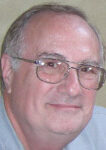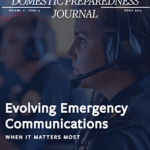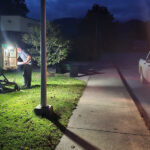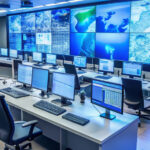Many citizens served their communities heroically in the aftermath of Hurricane Katrina, and some of their stories are well known – but most of them remain untold. One of the still relatively unknown heroes is a legally blind New Orleans jazz musician, who also happens to be an amateur radio operator – one of more than 676,000 FCC-licensed amateur radio operators living throughout the United States – who came to New Orleans’ Charity Hospital to set up his own battery-operated station in anticipation of the storm, and to be ready to help as and when needed.
Not long after Katrina first hit the New Orleans area, a pregnant woman, already in labor, waded through the muddy water and made her way into the hospital. The Charity doctors concurred that she needed a C-section, but with no phones, electricity, or running water available were not able to carry out such a complicated procedure at the hospital itself, so an evacuation helicopter would be required. The doctors turned to the ham, who made the call needed and started a communications chain that led to the successful evacuation. Thanks to the service provided by this single amateur radio operator, two lives were saved – the mother’s, and the baby’s.
In the aftermath of Katrina-type weather disasters – or any other mass-casualty incident – there is always a critical need to communicate with the outside world. For many responder agencies, amateur radio is therefore a true national resource – indeed, some might say, “a national treasure.” And one of the crown jewels of that treasure is the Amateur Radio Emergency Service (ARES®) – organized by the American Radio Relay League (ARRL), the national association for Amateur Radio, which in the United States is structured on a county-by-county basis.
ARES ham radio members, who come from all walks of life, freely volunteer their time, equipment, and expertise to benefit their local communities. As trained communicators, they are proficient in relaying vital messages quickly, effectively, and efficiently.
Welcome Financial Help, but an Unfortunate Presumption
Following Katrina, and in response to requests from several state and local government agencies, the U.S. Department of Homeland Security (DHS) provided preparedness funds to help meet the anticipated communications needs of numerous state public health agencies. In Georgia, for example, the state Division of Public Health used the DHS funding to install ham radio stations in 15 regional coordinating hospitals. Each of those stations is staffed by local ARES volunteers, who stand ready to provide reliable communications between and among the hospitals themselves, the Georgia Division of Public Health, and the amateur-radio community at large.
Even without a regional disaster to provide additional incentive, amateur radio operators are and have been there, for many years, to help support public and non-profit organizations by providing emergency communications at an untold number of civic special events in cities and counties throughout the country.
Some organizations presume, erroneously, that the ham radio community will be there when their normal means of communications fail. The truth is, though, that amateur radio supports, but does not replace, crucial communication assets operated by local government and non-profit agencies. To date, hams have proven themselves invaluable – so much so that, as David Sumner, K1ZZ, the ARRL’s chief executive officer, points out in his September 2009 QST magazine editorial, “The problem is [that] we have become victims of our own success.”
Amateur radio, when used as a communications tool in times of disaster, should therefore be recognized for being exactly what it is: an important aspect of a highly diverse hobby. Nonetheless, numerous widespread emergencies, spread over the past several decades, have shown that amateur radio can – and frequently does – provide on-the-ground, first-hand reports to those living and working outside the areas most directly affected (by a hurricane, tornado, wildfire, or other danger). Amateur radio operators are, above all, communicators. As such, they possess the skills, knowledge, and will to adapt to the environment in which they find themselves. In short, they are able to get the message through “when all else fails.”
A Sudden Emergency, an Immediate Response
That certainly was the case in Atlanta just over 18 months ago – i.e., in March 2008, when a thunderstorm unexpectedly strengthened and spawned tornadoes as it moved across Atlanta’s downtown area. The winds reached 130 miles per hour and cut a six-mile path of destruction. Because there was no anticipated need, the Skywarn Net (hams trained to observe and report weather conditions for the National Weather Service [NWS]) was not operational – this storm gave no warning.
Over a radio repeater, though, one lone voice, using only a hand-held radio, kept calling “CQ, CQ” – the message that hams use to call for any station on the air. The ham calling in this instance, who found himself positioned in the worst of the storm-affected area, was trying – as he went door to door, checking on his neighbors – to contact a land-based station to report fallen trees, downed power lines, and the general damage resulting from the tornado.
Another station heard the call, responded, and an ad hoc emergency net was established. For five hours, hams throughout the Atlanta area fielded storm reports and relayed damage observations to the National Weather Service, while also providing vital information to the appropriate hospital and public-safety officials who were in the process of establishing a unified command center.
Strict Financial Rules – With a Common-Sense Exception
Accreditation organizations in the public-health arena recognize the contributions made by amateur radio and have been encouraging the installation of amateur radio stations in key facilities (and reporting such installation in the facility’s professional evaluation). Such recognition is gratifying, obviously, but it also presents a dilemma of sorts both to the healthcare facility and to the individual ham radio licensees at the facility. Those hams, who are also employees of the emergency organization, must use caution not to violate the FCC (Federal Communications Commission) rules addressing pecuniary interest.
Some hospitals have established in-house amateur radio clubs, and – by offering these and opening the hospital station to employees for recreational purposes during off-duty hours – actively encourage interested employees to attain their ham licenses. These helpful activities sometimes lead to an incorrect impression, though – namely, that the ham radio station can be used to carry out hospital business when the hospital’s primary communications channels are down.
That is not quite the way the system works, though. The FCC is quite clear in its rules pertaining to amateur radio: “No amateur shall transmit communications in which the station licensee, or control operator, has a pecuniary interest, including communications on behalf of an employer.” In a genuine emergency, however, the FCC also says, “This rule may be waived for the duration of a clearly defined emergency.” There are some very narrow exceptions to this long-standing rule, but during times of conflicting directions from differing federal agencies, the FCC ruling must be strictly observed.
Nonetheless, when it comes to supporting the interest of the public, especially in times of widespread disaster, the nation’s amateur radio community can almost always be found front and center, lending time, equipment, and the individual and collective expertise of the hundreds of thousands of the nation’s ham operators to public health and relief agencies that are responding to the needs of the American people.
For additional information:
About the American Radio Relay League, click on www.arrl.org
About ARES, click on https://www.arrl.org/public-service
About the Hurricane Watch Net, click on www.hwn.org
About the Joint Commission’s Standing Together, An Emergency Planning Guide for America’s Communities, click on https://www.jointcommission.org/resources/news-and-multimedia/#t=_Tab_News-Releases&sort=%40newspublishdate%20descending&f:@sitelongname=[The%20Joint%20Commission]

Barry Kanne
Barry Kanne is the assistant section emergency coordinator for public health, Amateur Radio Emergency Service, Georgia Section, of the American Radio Relay League. A licensed amateur radio operator since 1953, he is currently president of TGA Communications, LLC, in Atlanta, Georgia.
- Barry Kannehttps://domesticpreparedness.com/author/barry-kanne






